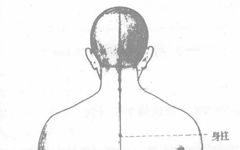1. The Marvelous Use of Shen Zhu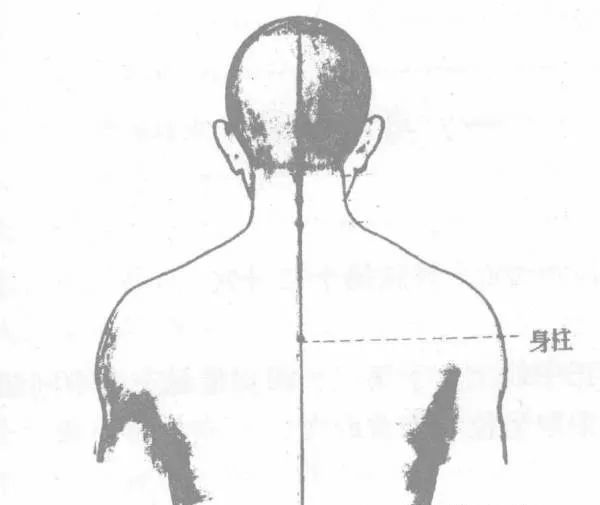 Shen Zhu (Shen Zhu, Du Mai No. 12)Location: Located on the midline of the spine, at the depression between the spinous processes of the third and fourth thoracic vertebrae. The patient should be seated and bend forward to locate the point. Needling Technique: Use a 1.5-inch, 28-gauge needle (length 4.5 cm, diameter 0.32 mm) to insert directly into the acupoint without deviation. If resistance is felt at the tip of the needle, it should reach the upper side of the spinal membrane. If the needle feels soft, it indicates misplacement, and it should be withdrawn and reinserted directly into the acupoint. If the needle accidentally enters the pleura, there is a risk of pneumothorax. Once the needle reaches the appropriate depth, it should be kept straight and left in place for 20 to 30 minutes. When removing the needle, first gently twist the handle, and when the needle body feels loose, withdraw it slowly while applying pressure with a sterile cotton ball for a moment. Effects: (1) Increases Strength1. For those with congenital deficiencies or acquired deficiencies; 2. For those with pale complexion and poor appetite; 3. For those who have not responded to multiple acupuncture treatments. (2) Prevents Colds1. Needle before going out on cold or windy days; 2. During the flu season; 3. When someone in the same room has a cold; 4. For those who frequently catch colds. (3) Reduces High Fever1. For high fever due to colds reaching 39°C, sweating occurs 30 minutes after needling, and the fever subsides, providing relief. 2. For those who frequently experience low-grade fevers. (4) Pediatric Conditions Conditions such as childhood malnutrition, convulsions, diarrhea, and parasitic infections can be treated by moxibustion on Shen Zhu for ten minutes, once daily for 3 to 7 days. Case Examples: 1. High Fever: In 1984, during a preparatory meeting at Guangming Correspondence University, a representative suddenly developed a high fever at night and was treated with Shen Zhu. After half an hour, he sweated profusely and the fever subsided. 2. Cold: At Liaoning University of Traditional Chinese Medicine, four teachers who frequently caught colds each received three treatments at Shen Zhu and subsequently did not catch colds again. Therefore, needling Shen Zhu has proven effective in preventing colds through multiple experiments. 2. Post-Acupuncture Pain Some patients report pain in a specific area, while the skin appears normal, and the pain is precisely at the acupoint. The cause is due to post-acupuncture effects. Inquiring with the original treating physician, since there was no change at the acupoint, the physician could not resolve it, and it cannot be considered a treatment error, yet the patient experiences pain. My treatment method is simple: needle the corresponding point relative to the painful acupoint. For example, if there is pain at Nei Guan, needle Wai Guan; if there is pain at Yang Ling Quan, needle Yin Ling Quan. If the two points correspond accurately, it should resolve without needing to needle the original point, hence termed “post-acupuncture pain.” Case Example: Wang XX, a 50-year-old housewife, reported pain on the inner side of her left wrist, which persisted after acupuncture treatment for insomnia. The pain was tolerable but interfered with daily life. She consulted the original treating physician, who could not resolve it. The acupoint showed no redness or swelling, and the physician bore no responsibility, but the pain persisted, and medication was ineffective. I used relative needling and achieved resolution. Similar cases are numerous. 3. Great Meridian Connection The “Nei Jing: Hai Lun” describes meridians as “internally connected to the organs and externally linked to the limbs and joints.” The meridians distribute throughout the body, connecting to the brain and linking to the organs, facilitating the flow of Qi and blood. When the meridians are balanced, there is no illness. When imbalanced, illness occurs. For diseases that do not respond to multiple acupuncture treatments, the Great Meridian Connection technique can be applied. The specific method involves using a 1-inch, 28-gauge needle, needling only one side each time, targeting the source and connecting points of the twelve meridians in the order of their flow, needling each point once without leaving the needle in place. Each session needles one side, alternating sides for a total of four sessions. For chronic conditions, needle from the source point to the connecting point; for new conditions, needle from the connecting point to the source point. (1) From Source to Connecting Point: Lung Source Tai Yuan – Large Intestine Connecting Pian Li – Stomach Source Chong Yang – Spleen Connecting Gong Sun – Heart Source Shen Men – Small Intestine Connecting Zhi Zheng – Bladder Source Jing Gu – Kidney Connecting Da Zhong – Pericardium Connecting Da Ling – Triple Burner Connecting Wai Guan – Gallbladder Source Qiu Xu – Liver Connecting Li Gou. Image of Twelve Source Points
Shen Zhu (Shen Zhu, Du Mai No. 12)Location: Located on the midline of the spine, at the depression between the spinous processes of the third and fourth thoracic vertebrae. The patient should be seated and bend forward to locate the point. Needling Technique: Use a 1.5-inch, 28-gauge needle (length 4.5 cm, diameter 0.32 mm) to insert directly into the acupoint without deviation. If resistance is felt at the tip of the needle, it should reach the upper side of the spinal membrane. If the needle feels soft, it indicates misplacement, and it should be withdrawn and reinserted directly into the acupoint. If the needle accidentally enters the pleura, there is a risk of pneumothorax. Once the needle reaches the appropriate depth, it should be kept straight and left in place for 20 to 30 minutes. When removing the needle, first gently twist the handle, and when the needle body feels loose, withdraw it slowly while applying pressure with a sterile cotton ball for a moment. Effects: (1) Increases Strength1. For those with congenital deficiencies or acquired deficiencies; 2. For those with pale complexion and poor appetite; 3. For those who have not responded to multiple acupuncture treatments. (2) Prevents Colds1. Needle before going out on cold or windy days; 2. During the flu season; 3. When someone in the same room has a cold; 4. For those who frequently catch colds. (3) Reduces High Fever1. For high fever due to colds reaching 39°C, sweating occurs 30 minutes after needling, and the fever subsides, providing relief. 2. For those who frequently experience low-grade fevers. (4) Pediatric Conditions Conditions such as childhood malnutrition, convulsions, diarrhea, and parasitic infections can be treated by moxibustion on Shen Zhu for ten minutes, once daily for 3 to 7 days. Case Examples: 1. High Fever: In 1984, during a preparatory meeting at Guangming Correspondence University, a representative suddenly developed a high fever at night and was treated with Shen Zhu. After half an hour, he sweated profusely and the fever subsided. 2. Cold: At Liaoning University of Traditional Chinese Medicine, four teachers who frequently caught colds each received three treatments at Shen Zhu and subsequently did not catch colds again. Therefore, needling Shen Zhu has proven effective in preventing colds through multiple experiments. 2. Post-Acupuncture Pain Some patients report pain in a specific area, while the skin appears normal, and the pain is precisely at the acupoint. The cause is due to post-acupuncture effects. Inquiring with the original treating physician, since there was no change at the acupoint, the physician could not resolve it, and it cannot be considered a treatment error, yet the patient experiences pain. My treatment method is simple: needle the corresponding point relative to the painful acupoint. For example, if there is pain at Nei Guan, needle Wai Guan; if there is pain at Yang Ling Quan, needle Yin Ling Quan. If the two points correspond accurately, it should resolve without needing to needle the original point, hence termed “post-acupuncture pain.” Case Example: Wang XX, a 50-year-old housewife, reported pain on the inner side of her left wrist, which persisted after acupuncture treatment for insomnia. The pain was tolerable but interfered with daily life. She consulted the original treating physician, who could not resolve it. The acupoint showed no redness or swelling, and the physician bore no responsibility, but the pain persisted, and medication was ineffective. I used relative needling and achieved resolution. Similar cases are numerous. 3. Great Meridian Connection The “Nei Jing: Hai Lun” describes meridians as “internally connected to the organs and externally linked to the limbs and joints.” The meridians distribute throughout the body, connecting to the brain and linking to the organs, facilitating the flow of Qi and blood. When the meridians are balanced, there is no illness. When imbalanced, illness occurs. For diseases that do not respond to multiple acupuncture treatments, the Great Meridian Connection technique can be applied. The specific method involves using a 1-inch, 28-gauge needle, needling only one side each time, targeting the source and connecting points of the twelve meridians in the order of their flow, needling each point once without leaving the needle in place. Each session needles one side, alternating sides for a total of four sessions. For chronic conditions, needle from the source point to the connecting point; for new conditions, needle from the connecting point to the source point. (1) From Source to Connecting Point: Lung Source Tai Yuan – Large Intestine Connecting Pian Li – Stomach Source Chong Yang – Spleen Connecting Gong Sun – Heart Source Shen Men – Small Intestine Connecting Zhi Zheng – Bladder Source Jing Gu – Kidney Connecting Da Zhong – Pericardium Connecting Da Ling – Triple Burner Connecting Wai Guan – Gallbladder Source Qiu Xu – Liver Connecting Li Gou. Image of Twelve Source Points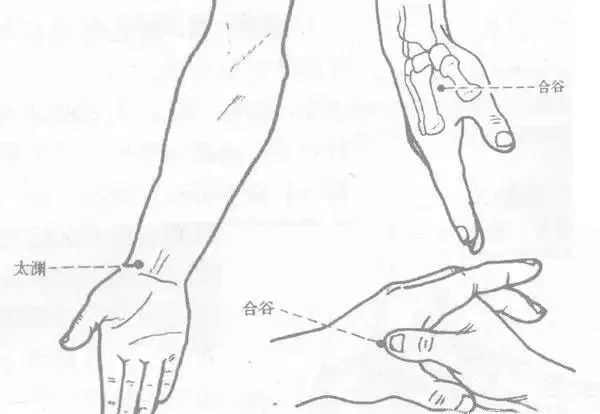
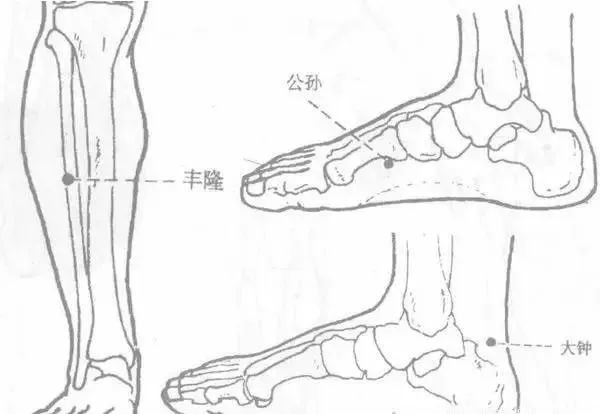
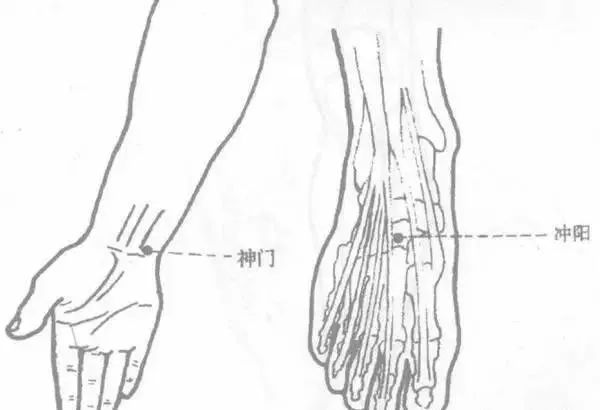
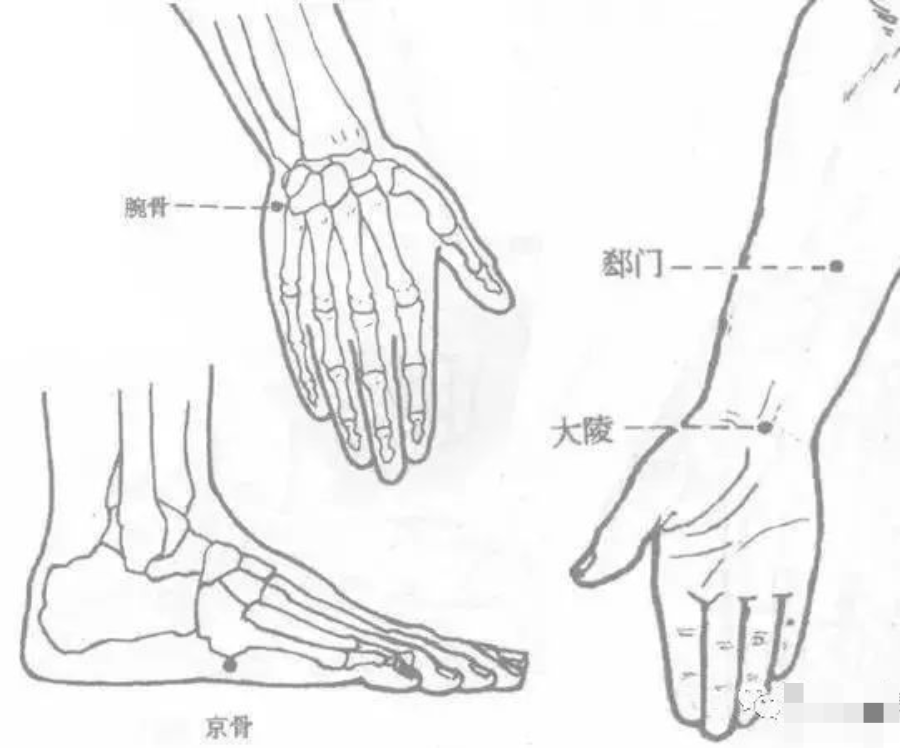
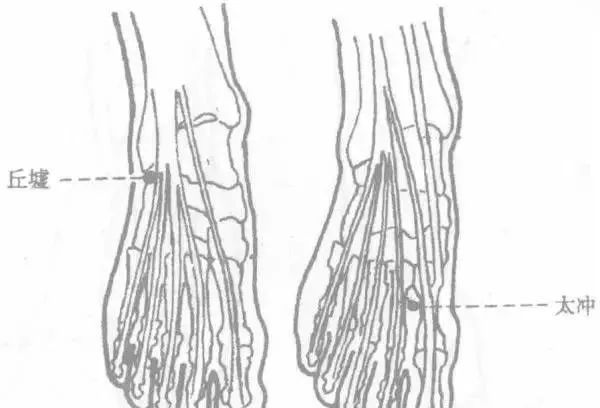
 Image of Twelve Connecting Points
Image of Twelve Connecting Points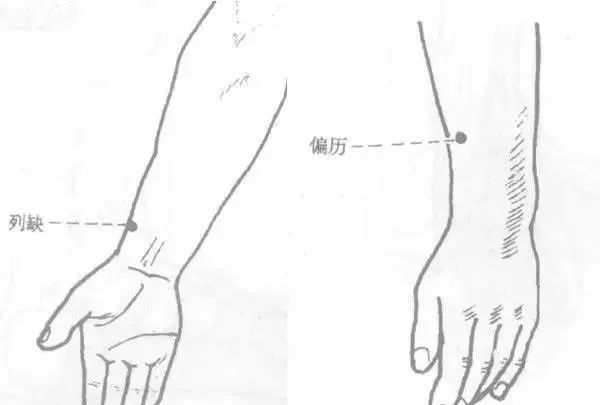

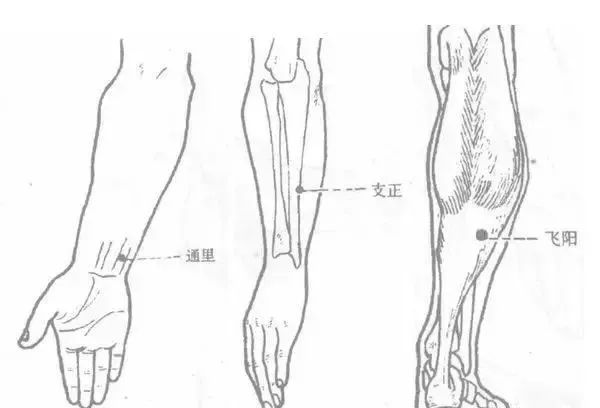 (2) From Connecting Point to Source Point: Lung Connecting Lie Que – Large Intestine Source He Gu – Stomach Connecting Feng Long – Spleen Source Tai Bai – Heart Connecting Tong Li – Small Intestine Source Wan Gu – Bladder Connecting Fei Yang – Kidney Source Tai Xi – Pericardium Connecting Nei Guan – Triple Burner Source Yang Chi – Gallbladder Connecting Qiu Xu – Liver Source Tai Chong. Case Example: Liu X, a 40-year-old accountant, reported fatigue in his limbs, reduced appetite, restless sleep, general weakness, constipation, and scanty urination, with worsening symptoms over three months. He also experienced premature ejaculation and nocturnal emissions. Diagnosis revealed a pale complexion, lack of energy, a moist tongue without coating, and a weak pulse. The pattern was identified as deficiency of both spleen and stomach. The treatment plan involved needling Shen Men for the heart, Tai Xi for the kidneys, and San Li for strengthening the stomach, along with San Yin Jiao to support the spleen. After ineffective treatment, the pulse showed no vitality. The Great Meridian Connection method was then applied, needling from source to connecting points and vice versa, resulting in gradual improvement. Afterward, needling the previously mentioned points five times led to a rosy complexion, increased energy, improved appetite, regular bowel movements, and resolution of premature ejaculation and nocturnal emissions, with complete recovery. 4. Acupuncture Techniques for Low Back Pain The meridians of the human body respond to each other in front and back, and connect left and right. The Ren Mai is the anterior midline, while the Du Mai is the posterior midline. The kidney meridian corresponds to the Hua Tuo Jia Ji points (now known as spinal points), the stomach meridian corresponds to the first line of the bladder, and the liver and spleen correspond to the second line of the bladder. The six meridians of the hands and feet also correspond front and back. Therefore, relative needling often yields quick results. Treatment for low back pain using relative needling involves locating the most painful point in the low back area by applying pressure. If a large area is painful and no specific point can be identified, this method is not applicable. Once the painful point is identified, mark it with red. Then locate the Ming Men point to calculate the total acupoint. For example, if the painful point is 15 cm to the left of Ming Men, needle 6 cm below it. Have the patient lie supine, measure 15 cm to the left of the navel, and needle 1.5 inches deep. If the painful point is not accurately targeted, withdraw the needle halfway and explore the surrounding area without leaving the needle in place. Have the patient turn prone, and once the painful point disappears, the low back pain is resolved. The Ming Men (Ming Men, Du Mai No. 4) is located in the midline of the spine, at the depression below the spinous process of the second lumbar vertebra. It is opposite the navel, but for those practicing Qigong, the navel may shift slightly downward. This method is remarkably effective, but accuracy in locating the painful point and the corresponding abdominal point is crucial. Mastering these three aspects ensures effective treatment. Case Example: Xia XX, a 45-year-old factory driver, suffered from low back pain for nine months, making it difficult to bend or walk, causing significant distress and inability to work. He underwent various treatments, spending over 280 prescriptions, including many Western medications, and received over 70 acupuncture treatments, yet the pain persisted, leading to great anxiety. Upon examination, he appeared distressed, with a slightly dark complexion and lack of energy. His tongue was moist and slightly dark, and his pulse was deep and slow, with weak pulses in both wrists. The diagnosis was attributed to kidney deficiency and cold. He was instructed to lie prone, and the painful point was located 3 cm to the left of Ming Men, which was extremely painful upon pressure. A mark was made, and he was instructed to lie supine, which was very difficult for him. The needle was inserted 3 cm to the left of the navel, and the needle was withdrawn 1/3 to explore in all directions. After this, he was able to lift his waist off the bed by 5 or 6 cm, exclaiming, “I feel light!” The pain had disappeared when he pressed the painful point again. The next day, he returned for a follow-up, driving himself and smiling, saying, “After resting for 9 months, I am back to work. I only feel slight discomfort in my lower back, and the pain is completely gone.” Upon pressing the painful point, there was slight tenderness, and he was treated again, resulting in complete recovery. This patient had an interesting episode. At that time, the “Liaoning Journal of Traditional Chinese Medicine” was in trial publication. I wrote a report about this case, and although the Cultural Revolution had passed, there were still lingering fears. The editor sent someone to investigate the factory, and after returning, they were still not at ease and conducted a second investigation. This caused the patient to become angry and personally visit the editorial office, saying, “Why don’t you believe the doctor and the patient? I have never met the doctor before, suffered for nine months, and was cured twice by him. I returned to work the next day, and now I am completely well. What does your repeated investigation mean?” After the relevant personnel explained that “the publication must be based on facts and thorough investigation for accuracy, please do not misunderstand,” the matter was amicably resolved. 5. Root Cutting Therapy(1) IndicationsThis method is suitable for conditions such as scrofula, mammary gland hyperplasia, scalp sores, acne, and chronic boils that persist and recur, as well as urticaria. (2) Needling TechniqueFinding the Acupoint:Using the nipple as a reference, place one end of a measuring tape at the left nipple and stretch it horizontally to the right nipple. Release the left nipple and extend the tape towards the right shoulder, passing over the neck and descending to the left nipple. Align the tape from both nipples, allowing it to drop from the front of the neck to the back, with the end of the tape indicating the acupoint. Depending on the patient’s body type, this acupoint is approximately near the liver shu point. For women with sagging breasts after childbirth, needle directly down from the Qi Hu point to the fifth intercostal space. Needle: Use a 2-inch needle with a diameter of 1 mm, sterilized under high pressure. If this equipment is not available, soaking in 95% alcohol for 30 minutes is also acceptable. Needling Technique:Accurately locate the acupoint, disinfect thoroughly, pinch the skin at the acupoint with the thumb and index finger of the left hand, and insert the needle at a slight angle of 15 degrees towards the spine with the right hand. The patient should not feel much pain. Leave the needle in for 20 minutes; for severe cases, it can be left for 30 minutes, and needle again every three days until recovery is achieved. Case Examples: 1. Mammary Gland Hyperplasia: Cao X, a 25-year-old teacher from Benxi County, Liaoning Province, had hard lumps the size of pigeon eggs in both breasts for several months, with tenderness upon pressure. She experienced reduced appetite, weight loss, pale complexion, lack of energy, poor sleep, and depression, with weak pulses, especially in the two guan pulses. After ineffective medication, she underwent root cutting therapy eight times, resulting in the disappearance of the hyperplastic lumps, increased appetite, improved sleep, and revitalization, leading to her recovery. 2. Acne: Ma XX, a 25-year-old university student, had numerous acne lesions on his face that were progressively worsening, causing discomfort both physically and emotionally. After ineffective treatments, he underwent root cutting therapy and was cured after four sessions, achieving a clear complexion and revitalized spirit. 6. Pain Point Pain Relief Method The relative needling technique in acupuncture involves needling the healthy side for pain on the affected side, selecting the corresponding acupoint on the healthy side, which yields good results and is a method for adjusting meridian balance. The “Pain Point Pain Relief Method” is specifically designed for treating small areas of pain. It can be used for pain anywhere in the body, but is limited to small areas of pain with a diameter of 1 cm or less. This method is simple to perform, yields rapid results, and can achieve pain relief with needle insertion. The specific method involves using a 30-gauge, 1-inch needle, quickly inserting it into the corresponding side of the pain point. For example, if the pain is at Nei Guan, needle Wai Guan; if the pain is at Yang Ling Quan, needle Yin Ling Quan. This technique can be applied to any part of the head, face, chest, abdomen, and limbs. There are also less obvious corresponding points, such as if there is a pain point at the top of the head, due to the neck’s relationship, it may not be possible to find a corresponding point on both sides. For instance, if the pain point is at the front top, needle Lian Quan; if the pain point is at Bai Hui, there is no corresponding point. However, this is only for very few localized pains; most areas of the body have opposing points. For joint areas, such as “tennis elbow,” the pain point is below the elbow joint, where there is little flesh and more bone, making it difficult to find an accurate corresponding point, resulting in less effectiveness. However, this is only for very few localized pains. Most areas of the body can find absolute opposing points. This method is the simplest and can achieve “effective needling” without needing to leave the needle in place; a quick jab can relieve pain. There are many cases, too numerous to list. In 1993, a child with persistent localized pain in the forehead visited the clinic, having suffered for three months, with treatment costs exceeding 1000 yuan without effect. After using this method, the child was cured, with only a 10 yuan registration fee. 7. Rapid Blood Pressure Reduction This method is most effective for primary hypertension, not secondary to other diseases. Even if secondary hypertension is present, the effect on blood pressure reduction is still significant, but if the underlying disease causing hypertension is not resolved, hypertension cannot be completely cured, only alleviated. Acupuncture points: Among the eight meeting points, the “Ge Yu” point is well-known in the acupuncture community. The Ge Yu blood pressure reduction method is simple to perform; as long as the acupoint is accurately located, inserting one 1-gauge subcutaneous needle on each side will lead to a decrease in blood pressure. In winter, the needle can be left for five days; in summer, due to frequent bathing, it can be left for three days. After removing the needle, wait one day before continuing to insert needles. Image of Ge Yu
(2) From Connecting Point to Source Point: Lung Connecting Lie Que – Large Intestine Source He Gu – Stomach Connecting Feng Long – Spleen Source Tai Bai – Heart Connecting Tong Li – Small Intestine Source Wan Gu – Bladder Connecting Fei Yang – Kidney Source Tai Xi – Pericardium Connecting Nei Guan – Triple Burner Source Yang Chi – Gallbladder Connecting Qiu Xu – Liver Source Tai Chong. Case Example: Liu X, a 40-year-old accountant, reported fatigue in his limbs, reduced appetite, restless sleep, general weakness, constipation, and scanty urination, with worsening symptoms over three months. He also experienced premature ejaculation and nocturnal emissions. Diagnosis revealed a pale complexion, lack of energy, a moist tongue without coating, and a weak pulse. The pattern was identified as deficiency of both spleen and stomach. The treatment plan involved needling Shen Men for the heart, Tai Xi for the kidneys, and San Li for strengthening the stomach, along with San Yin Jiao to support the spleen. After ineffective treatment, the pulse showed no vitality. The Great Meridian Connection method was then applied, needling from source to connecting points and vice versa, resulting in gradual improvement. Afterward, needling the previously mentioned points five times led to a rosy complexion, increased energy, improved appetite, regular bowel movements, and resolution of premature ejaculation and nocturnal emissions, with complete recovery. 4. Acupuncture Techniques for Low Back Pain The meridians of the human body respond to each other in front and back, and connect left and right. The Ren Mai is the anterior midline, while the Du Mai is the posterior midline. The kidney meridian corresponds to the Hua Tuo Jia Ji points (now known as spinal points), the stomach meridian corresponds to the first line of the bladder, and the liver and spleen correspond to the second line of the bladder. The six meridians of the hands and feet also correspond front and back. Therefore, relative needling often yields quick results. Treatment for low back pain using relative needling involves locating the most painful point in the low back area by applying pressure. If a large area is painful and no specific point can be identified, this method is not applicable. Once the painful point is identified, mark it with red. Then locate the Ming Men point to calculate the total acupoint. For example, if the painful point is 15 cm to the left of Ming Men, needle 6 cm below it. Have the patient lie supine, measure 15 cm to the left of the navel, and needle 1.5 inches deep. If the painful point is not accurately targeted, withdraw the needle halfway and explore the surrounding area without leaving the needle in place. Have the patient turn prone, and once the painful point disappears, the low back pain is resolved. The Ming Men (Ming Men, Du Mai No. 4) is located in the midline of the spine, at the depression below the spinous process of the second lumbar vertebra. It is opposite the navel, but for those practicing Qigong, the navel may shift slightly downward. This method is remarkably effective, but accuracy in locating the painful point and the corresponding abdominal point is crucial. Mastering these three aspects ensures effective treatment. Case Example: Xia XX, a 45-year-old factory driver, suffered from low back pain for nine months, making it difficult to bend or walk, causing significant distress and inability to work. He underwent various treatments, spending over 280 prescriptions, including many Western medications, and received over 70 acupuncture treatments, yet the pain persisted, leading to great anxiety. Upon examination, he appeared distressed, with a slightly dark complexion and lack of energy. His tongue was moist and slightly dark, and his pulse was deep and slow, with weak pulses in both wrists. The diagnosis was attributed to kidney deficiency and cold. He was instructed to lie prone, and the painful point was located 3 cm to the left of Ming Men, which was extremely painful upon pressure. A mark was made, and he was instructed to lie supine, which was very difficult for him. The needle was inserted 3 cm to the left of the navel, and the needle was withdrawn 1/3 to explore in all directions. After this, he was able to lift his waist off the bed by 5 or 6 cm, exclaiming, “I feel light!” The pain had disappeared when he pressed the painful point again. The next day, he returned for a follow-up, driving himself and smiling, saying, “After resting for 9 months, I am back to work. I only feel slight discomfort in my lower back, and the pain is completely gone.” Upon pressing the painful point, there was slight tenderness, and he was treated again, resulting in complete recovery. This patient had an interesting episode. At that time, the “Liaoning Journal of Traditional Chinese Medicine” was in trial publication. I wrote a report about this case, and although the Cultural Revolution had passed, there were still lingering fears. The editor sent someone to investigate the factory, and after returning, they were still not at ease and conducted a second investigation. This caused the patient to become angry and personally visit the editorial office, saying, “Why don’t you believe the doctor and the patient? I have never met the doctor before, suffered for nine months, and was cured twice by him. I returned to work the next day, and now I am completely well. What does your repeated investigation mean?” After the relevant personnel explained that “the publication must be based on facts and thorough investigation for accuracy, please do not misunderstand,” the matter was amicably resolved. 5. Root Cutting Therapy(1) IndicationsThis method is suitable for conditions such as scrofula, mammary gland hyperplasia, scalp sores, acne, and chronic boils that persist and recur, as well as urticaria. (2) Needling TechniqueFinding the Acupoint:Using the nipple as a reference, place one end of a measuring tape at the left nipple and stretch it horizontally to the right nipple. Release the left nipple and extend the tape towards the right shoulder, passing over the neck and descending to the left nipple. Align the tape from both nipples, allowing it to drop from the front of the neck to the back, with the end of the tape indicating the acupoint. Depending on the patient’s body type, this acupoint is approximately near the liver shu point. For women with sagging breasts after childbirth, needle directly down from the Qi Hu point to the fifth intercostal space. Needle: Use a 2-inch needle with a diameter of 1 mm, sterilized under high pressure. If this equipment is not available, soaking in 95% alcohol for 30 minutes is also acceptable. Needling Technique:Accurately locate the acupoint, disinfect thoroughly, pinch the skin at the acupoint with the thumb and index finger of the left hand, and insert the needle at a slight angle of 15 degrees towards the spine with the right hand. The patient should not feel much pain. Leave the needle in for 20 minutes; for severe cases, it can be left for 30 minutes, and needle again every three days until recovery is achieved. Case Examples: 1. Mammary Gland Hyperplasia: Cao X, a 25-year-old teacher from Benxi County, Liaoning Province, had hard lumps the size of pigeon eggs in both breasts for several months, with tenderness upon pressure. She experienced reduced appetite, weight loss, pale complexion, lack of energy, poor sleep, and depression, with weak pulses, especially in the two guan pulses. After ineffective medication, she underwent root cutting therapy eight times, resulting in the disappearance of the hyperplastic lumps, increased appetite, improved sleep, and revitalization, leading to her recovery. 2. Acne: Ma XX, a 25-year-old university student, had numerous acne lesions on his face that were progressively worsening, causing discomfort both physically and emotionally. After ineffective treatments, he underwent root cutting therapy and was cured after four sessions, achieving a clear complexion and revitalized spirit. 6. Pain Point Pain Relief Method The relative needling technique in acupuncture involves needling the healthy side for pain on the affected side, selecting the corresponding acupoint on the healthy side, which yields good results and is a method for adjusting meridian balance. The “Pain Point Pain Relief Method” is specifically designed for treating small areas of pain. It can be used for pain anywhere in the body, but is limited to small areas of pain with a diameter of 1 cm or less. This method is simple to perform, yields rapid results, and can achieve pain relief with needle insertion. The specific method involves using a 30-gauge, 1-inch needle, quickly inserting it into the corresponding side of the pain point. For example, if the pain is at Nei Guan, needle Wai Guan; if the pain is at Yang Ling Quan, needle Yin Ling Quan. This technique can be applied to any part of the head, face, chest, abdomen, and limbs. There are also less obvious corresponding points, such as if there is a pain point at the top of the head, due to the neck’s relationship, it may not be possible to find a corresponding point on both sides. For instance, if the pain point is at the front top, needle Lian Quan; if the pain point is at Bai Hui, there is no corresponding point. However, this is only for very few localized pains; most areas of the body have opposing points. For joint areas, such as “tennis elbow,” the pain point is below the elbow joint, where there is little flesh and more bone, making it difficult to find an accurate corresponding point, resulting in less effectiveness. However, this is only for very few localized pains. Most areas of the body can find absolute opposing points. This method is the simplest and can achieve “effective needling” without needing to leave the needle in place; a quick jab can relieve pain. There are many cases, too numerous to list. In 1993, a child with persistent localized pain in the forehead visited the clinic, having suffered for three months, with treatment costs exceeding 1000 yuan without effect. After using this method, the child was cured, with only a 10 yuan registration fee. 7. Rapid Blood Pressure Reduction This method is most effective for primary hypertension, not secondary to other diseases. Even if secondary hypertension is present, the effect on blood pressure reduction is still significant, but if the underlying disease causing hypertension is not resolved, hypertension cannot be completely cured, only alleviated. Acupuncture points: Among the eight meeting points, the “Ge Yu” point is well-known in the acupuncture community. The Ge Yu blood pressure reduction method is simple to perform; as long as the acupoint is accurately located, inserting one 1-gauge subcutaneous needle on each side will lead to a decrease in blood pressure. In winter, the needle can be left for five days; in summer, due to frequent bathing, it can be left for three days. After removing the needle, wait one day before continuing to insert needles. Image of Ge Yu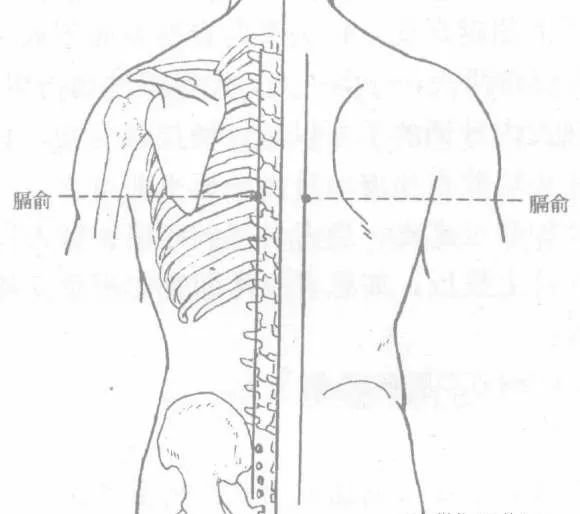 Ge Yu: Bladder Meridian No. 17, one of the eight meeting points (Blood Meeting). Location: In the prone position, below the spinous process of the seventh thoracic vertebra, 1.5 inches lateral to the Du Mai. Operation Method:Accurately locate the Ge Yu point, disinfect the skin, grasp the subcutaneous needle with tweezers, and with the thumb and index finger of the left hand, pull the skin tightly around the acupoint. Insert the subcutaneous needle horizontally from the center of the Ge Yu point towards the spine, ensuring the needle tip is inserted just beneath the skin and not beyond the dermis. After insertion, cut two pieces of adhesive tape, one small and one large. The larger piece should be no bigger than a fingernail. The smaller piece is first placed under the handle of the subcutaneous needle to prevent contact with the skin, then the larger piece is placed over the smaller piece and the needle, and pressed flat. If the subcutaneous needle penetrates beyond the dermis, the patient will feel pain. After insertion, the physician should press on the needle; if the patient feels pain, it is advisable to withdraw and reinsert carefully. Image of Eye Acupuncture Points
Ge Yu: Bladder Meridian No. 17, one of the eight meeting points (Blood Meeting). Location: In the prone position, below the spinous process of the seventh thoracic vertebra, 1.5 inches lateral to the Du Mai. Operation Method:Accurately locate the Ge Yu point, disinfect the skin, grasp the subcutaneous needle with tweezers, and with the thumb and index finger of the left hand, pull the skin tightly around the acupoint. Insert the subcutaneous needle horizontally from the center of the Ge Yu point towards the spine, ensuring the needle tip is inserted just beneath the skin and not beyond the dermis. After insertion, cut two pieces of adhesive tape, one small and one large. The larger piece should be no bigger than a fingernail. The smaller piece is first placed under the handle of the subcutaneous needle to prevent contact with the skin, then the larger piece is placed over the smaller piece and the needle, and pressed flat. If the subcutaneous needle penetrates beyond the dermis, the patient will feel pain. After insertion, the physician should press on the needle; if the patient feels pain, it is advisable to withdraw and reinsert carefully. Image of Eye Acupuncture Points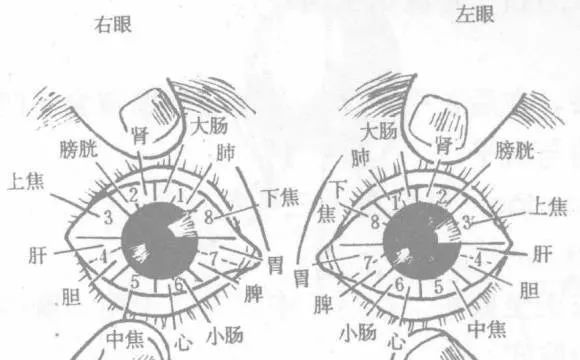 Eye acupuncture for blood pressure reduction: There are thirteen points in the eye acupuncture area, which have been documented in specialized texts, and many acupuncture books and journals have reported extensively on this. Here, I will only introduce the experience of using eye acupuncture for blood pressure reduction. Traditional Chinese medicine states, “The liver stores blood,” and “When a person lies down, blood returns to the liver,” illustrating the close relationship between the liver meridian and blood. Using eye acupuncture in the liver area for blood pressure reduction yields the fastest results. Measure blood pressure; if it is above the normal range, there is no need to remove the blood pressure cuff. Simply needle one point in each liver area of the eyes, and then measure blood pressure again; there will be a noticeable decrease. There are many methods for blood pressure reduction; I have proposed ten methods. However, among these, the Ge Yu subcutaneous needle and the eye acupuncture liver area are the fastest. Hypertension is a cardiovascular disease, and some patients have suffered from hypertension for decades without resolution. Experience tells us that temporary blood pressure reduction is easy, but complete and thorough cure is difficult. There are also patients with stubborn hypertension who do not respond to any method, although they are rare in clinical practice. 8. Effective Points for Insomnia Insomnia is a very distressing condition that can significantly impact health. The more one suffers from insomnia at night, the sleepier one feels during the day, leading to a vicious cycle of prolonged insomnia and resulting in neurasthenia. Symptoms include a pale complexion, lack of energy, poor appetite, dizziness, headaches, and memory decline, causing great distress. The best approach is to treat it promptly. Image of Du Mai Points
Eye acupuncture for blood pressure reduction: There are thirteen points in the eye acupuncture area, which have been documented in specialized texts, and many acupuncture books and journals have reported extensively on this. Here, I will only introduce the experience of using eye acupuncture for blood pressure reduction. Traditional Chinese medicine states, “The liver stores blood,” and “When a person lies down, blood returns to the liver,” illustrating the close relationship between the liver meridian and blood. Using eye acupuncture in the liver area for blood pressure reduction yields the fastest results. Measure blood pressure; if it is above the normal range, there is no need to remove the blood pressure cuff. Simply needle one point in each liver area of the eyes, and then measure blood pressure again; there will be a noticeable decrease. There are many methods for blood pressure reduction; I have proposed ten methods. However, among these, the Ge Yu subcutaneous needle and the eye acupuncture liver area are the fastest. Hypertension is a cardiovascular disease, and some patients have suffered from hypertension for decades without resolution. Experience tells us that temporary blood pressure reduction is easy, but complete and thorough cure is difficult. There are also patients with stubborn hypertension who do not respond to any method, although they are rare in clinical practice. 8. Effective Points for Insomnia Insomnia is a very distressing condition that can significantly impact health. The more one suffers from insomnia at night, the sleepier one feels during the day, leading to a vicious cycle of prolonged insomnia and resulting in neurasthenia. Symptoms include a pale complexion, lack of energy, poor appetite, dizziness, headaches, and memory decline, causing great distress. The best approach is to treat it promptly. Image of Du Mai Points Acupuncture points for treating insomnia: Da Zhui, Tao Dao, Shen Tang, used continuously, show good efficacy. Another prescription is to needle the An Mian point; if ineffective, a subcutaneous needle can be placed at An Mian. Da Zhui (Da Zhui, Du Mai No. 14) is located on the midline of the back, at the depression below the spinous process of the seventh cervical vertebra, approximately level with the shoulders. Tao Dao (Tao Dao, Du Mai No. 13) is located on the midline of the back, at the depression below the spinous process of the first thoracic vertebra, while Shen Tang (Shen Tang, Bladder Meridian No. 44) is located 3 inches lateral to the Shen Dao point, below the spinous process of the fifth thoracic vertebra. Image of An Mian Point
Acupuncture points for treating insomnia: Da Zhui, Tao Dao, Shen Tang, used continuously, show good efficacy. Another prescription is to needle the An Mian point; if ineffective, a subcutaneous needle can be placed at An Mian. Da Zhui (Da Zhui, Du Mai No. 14) is located on the midline of the back, at the depression below the spinous process of the seventh cervical vertebra, approximately level with the shoulders. Tao Dao (Tao Dao, Du Mai No. 13) is located on the midline of the back, at the depression below the spinous process of the first thoracic vertebra, while Shen Tang (Shen Tang, Bladder Meridian No. 44) is located 3 inches lateral to the Shen Dao point, below the spinous process of the fifth thoracic vertebra. Image of An Mian Point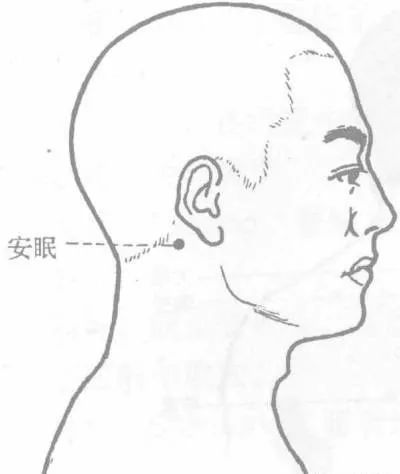 An Mian, an extraordinary point, is located in the neck, one inch below the depression at the termination of the sternocleidomastoid muscle. There are two points on each side. 9. Three Points for Treating Brain DisordersImage of Three Points for Treating Brain Disorders
An Mian, an extraordinary point, is located in the neck, one inch below the depression at the termination of the sternocleidomastoid muscle. There are two points on each side. 9. Three Points for Treating Brain DisordersImage of Three Points for Treating Brain Disorders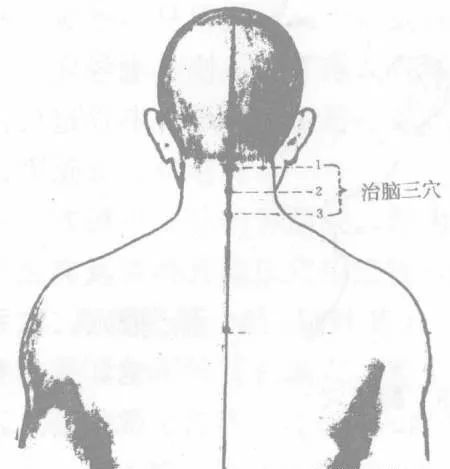 The points are located directly below the Ya Men point at the hairline, with one horizontal finger’s width between each point. They are used to treat all brain-related diseases, neck stiffness, and post-stroke aphasia. The causes of aphasia involve the collaborative action of the lips, teeth, tongue, and throat. If the tongue is short, the sublingual points can be needled. If there are no changes in the tongue, the Ya Men point can be needled, but caution is needed as the area above the Ya Men point is the medulla oblongata, and touching it poses risks. The first point for treating brain disorders is at the second cervical vertebra, the second point at the third cervical vertebra, and the third point at the fourth cervical vertebra, with the next horizontal finger being the fifth cervical vertebra, and the next horizontal finger being the sixth cervical vertebra, followed by the first thoracic vertebra; the two sides of the second cervical vertebra are Tian Zhu and Yi Feng, collectively known as the ten points of vertical and horizontal alignment. 10. Yi Feng for Toothache There are many causes of toothache, and the Yi Feng point is specifically for toothache caused by periodontal inflammation. The source of the disease may be due to complications from medication. The periodontal membrane may be directly impacted by trauma, or there may be bacterial infection from the dental pulp invading the periodontal membrane. Symptoms may include purulent or non-purulent pain, which is spontaneous and continuous, but not paroxysmal. Pain may intensify when tapping the tooth, which distinguishes it from pulpitis and is characteristic of periodontal inflammation. Periodontal inflammation is referred to in traditional Chinese medicine as “wind-fire toothache.” There are many acupuncture points for treating toothache, generally including Xia Guan, Jia Che, and He Gu, as well as Zu San Li and Nei Ting, which also have certain effects. However, these require leaving the needle in for several minutes or longer to relieve pain. In contrast, needling the Yi Feng point provides immediate pain relief upon insertion. Image of Yi Feng Point
The points are located directly below the Ya Men point at the hairline, with one horizontal finger’s width between each point. They are used to treat all brain-related diseases, neck stiffness, and post-stroke aphasia. The causes of aphasia involve the collaborative action of the lips, teeth, tongue, and throat. If the tongue is short, the sublingual points can be needled. If there are no changes in the tongue, the Ya Men point can be needled, but caution is needed as the area above the Ya Men point is the medulla oblongata, and touching it poses risks. The first point for treating brain disorders is at the second cervical vertebra, the second point at the third cervical vertebra, and the third point at the fourth cervical vertebra, with the next horizontal finger being the fifth cervical vertebra, and the next horizontal finger being the sixth cervical vertebra, followed by the first thoracic vertebra; the two sides of the second cervical vertebra are Tian Zhu and Yi Feng, collectively known as the ten points of vertical and horizontal alignment. 10. Yi Feng for Toothache There are many causes of toothache, and the Yi Feng point is specifically for toothache caused by periodontal inflammation. The source of the disease may be due to complications from medication. The periodontal membrane may be directly impacted by trauma, or there may be bacterial infection from the dental pulp invading the periodontal membrane. Symptoms may include purulent or non-purulent pain, which is spontaneous and continuous, but not paroxysmal. Pain may intensify when tapping the tooth, which distinguishes it from pulpitis and is characteristic of periodontal inflammation. Periodontal inflammation is referred to in traditional Chinese medicine as “wind-fire toothache.” There are many acupuncture points for treating toothache, generally including Xia Guan, Jia Che, and He Gu, as well as Zu San Li and Nei Ting, which also have certain effects. However, these require leaving the needle in for several minutes or longer to relieve pain. In contrast, needling the Yi Feng point provides immediate pain relief upon insertion. Image of Yi Feng Point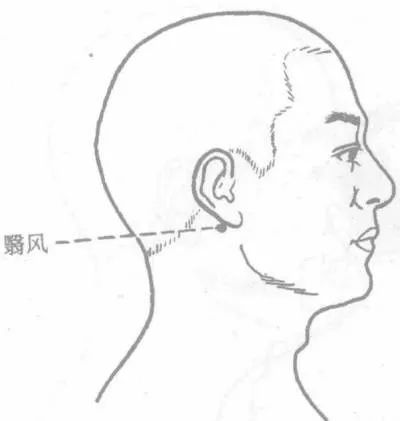 Yi Feng (Yi Feng, Hand Shao Yang No. 17) is located in the sitting position, behind the earlobe, in the depression between the lower jaw angle and the mastoid process. Pressing the point with a hand will elicit a pulling sensation in the ear canal. Needling technique: Use a 28-gauge, 1.5-inch needle, inserting it straight downwards at a 1-inch depth while applying slight rotation to enhance the needle sensation. Once the pain has stopped, the needle can be immediately removed. Generally, patients prefer to leave the needle in longer. In practice, if the pain persists after needling, it can be left in for a longer duration, but immediate pain relief is achieved with this point, making the duration of needle retention less significant. 11. Treating Boils with Meridian Techniques Boils are a surgical condition caused by infection, often occurring in areas exposed to the outside, particularly at the starting and ending points of meridians. They are most likely to appear on the fingertips, and in barefoot individuals, on the toes or face. Initially, they present as a small red dot, gradually becoming painful, accompanied by nausea, anxiety, and dizziness. Blood tests may show elevated white blood cell counts. To test for boils, chew a soybean; if a bean-like taste is detected, it is not a boil. If no taste is detected, it indicates a boil, and the chewed soybean can be applied to the boil. The fastest treatment method is acupuncture, as boils occurring on the face and extremities are at the starting and ending points of the meridians or near them. To determine which meridian is involved, needle the opposite end of the meridian. If the boil occurs at the starting point, needle the ending point; if it occurs at the ending point, needle the starting point. The starting and ending points are also known as the head and tail points. After needling, pain ceases, and symptoms such as nausea, anxiety, and dizziness disappear immediately. After 20 minutes, a follow-up blood test will show normalized white blood cell counts. Additionally, if there is inflammation in the lymphatic vessels near the boil, it is commonly referred to as a red line. The red line also follows the meridian pathway, hence Zhang Taiyan stated, “The meridian is the lymphatic system.” The treatment for lymphangitis also involves acupuncture, using a thick needle or three-edged needle to puncture the advancing end of the lymphatic vessel, allowing dark blood to be expelled, causing the red line to disappear. If needles are inserted every inch along the inflamed lymphatic vessel and a small amount of dark blood is expelled, recovery will be faster. If the soybean test is not performed, it is still effective to apply anti-inflammatory medication to the boil, leading to gradual healing. Case Example: Zhang XX, a 19-year-old student, suddenly developed a red dot on her face, followed by fever, anxiety, dizziness, and nausea, with the red dot on her face feeling hot and painful. Her complexion was red, tongue yellow, and pulse was deep and rapid, especially in the right guan pulse. Upon examination, a red dot the size of a soybean was found precisely at the Di Cang point, diagnosed as “locked mouth boil.” Although it was not at the stomach meridian’s starting point, it was very close to the fourth point. Urgently needled the stomach meridian’s stopping point, Li Dui, and after needling, symptoms of nausea and dizziness disappeared. After 20 minutes, a follow-up blood test showed white blood cell counts decreased from 12,000 to 7,000, indicating the boil was healing. The next day, upon follow-up, all symptoms had disappeared, with only a trace remaining at the site of the boil. Generally, complete recovery occurs within a few days. 12. Efficacy of the Four Seams Point The Four Seams points are located at the first and second finger joints of the index, middle, ring, and little fingers, corresponding to the large intestine, pericardium, triple burner, heart, and small intestine meridians. The fingers are sensitive nerve endings, making them effective for treating diseases. Indications include childhood malnutrition, bronchitis, roundworm infections, indigestion, and developmental delays. Needling Method: Disinfect the skin at the acupoint, have an assistant push from the fingertip towards the base a few times, then pinch the skin at the first finger joint, and the practitioner needles from the base towards the tip using a 26-gauge needle. White mucus will be expelled with the needle, which should be wiped clean. Generally, treatment is done every four days, and 4 to 5 sessions can lead to recovery. After needling, a decrease in white mucus indicates improvement, and the appearance of blood signifies recovery. Children with a pale complexion, thin physique, unkempt hair, poor appetite, and a slightly distended abdomen with visible veins or hard lumps are diagnosed with malnutrition. Generally, one treatment can significantly improve appetite, and several sessions can lead to recovery. This method is also effective for adults with thin physiques, poor appetite, and below-normal weight. It also shows good results for asthma. The sensitivity of the fingers makes adults wary of pain and resistant to needling. Adults should be explained and persuaded, while children may need to be held down by their parents during the procedure. The needle holes initially expel white mucus, which then turns to blood, indicating recovery. Case Examples: 1. Malnutrition: Li XX, a 7-year-old boy, presented with developmental delays, pale complexion, poor appetite, unkempt hair, and a distended abdomen with visible veins, diagnosed with malnutrition. After four sessions at the Four Seams points, his appetite gradually improved, and he became more energetic and active. His father jokingly remarked, “The child is better and can eat; we are influenced too and have a good appetite, which will cost us more for food.” Although it was a joke, it was also true. As the only child, he was the family’s treasure, transforming from a pale, thin child with poor appetite to one who could eat and drink well, making his parents happy and naturally improving their appetite. 2. Bronchitis: Meng XX, a 57-year-old factory manager, had suffered from bronchitis for many years, with severe symptoms in winter and occasional flare-ups in summer, remaining untreated. After needling the Four Seams points, a significant amount of white mucus was expelled, gradually reducing coughing and wheezing. After eight sessions, he was cured and has not had a recurrence for several years. 13. Ten Methods of Subcutaneous Needling Subcutaneous needling was initially used only to adjust meridians. After years of clinical use, we have accumulated experience with the following ten methods: 1. Adjusting meridians, initially using aromatic measurement, later using instruments for measurement and balance adjustment. In the 1950s, I conducted experiments predicting life and death based on meridian phenomena. Among hospitalized patients on the brink of death, six were notified to their families for mental preparation, three men and three women. Some had minimal readings on several meridians, while others had several meridians at zero, yet their Qi and blood were still present; others had low readings on all meridians, with only a few meridians showing better readings but no Qi and blood. Ultimately, the former group recovered, while the latter group all died, indicating that the human body is primarily governed by Qi and blood, with meridians serving as the circulatory pathways for Qi and blood, a concept worthy of further study. 2. For first-degree frostbite with severe redness and itching, bury a subcutaneous needle in the center of the sore. Recovery occurs within a few days. 3. For persistent pain where acupuncture is ineffective, bury a subcutaneous needle at the pain point to relieve pain. Another method is to have the patient stand and twist their body in various directions, burying a subcutaneous needle at the most painful point, which can relieve pain. 4. If the effect of acupuncture is not sustained, bury a subcutaneous needle at the effective acupoint to prolong the duration of the effect. 5. For insomnia, if other methods are ineffective, bury a subcutaneous needle at the An Mian point. 6. For children with bedwetting, needle both sides of the San Yin Jiao point, inserting one needle from below and one from above, with the directions reversed for better efficacy. 7. For women with insufficient milk production after childbirth, bury a subcutaneous needle at the Xuan Zhong point and apply pressure multiple times to promote milk secretion. 8. For eye acupuncture points, bury a subcutaneous needle to extend the duration of its effect. 9. For weight loss, bury a subcutaneous needle at the inner side of the Ting Gong point, pressing it multiple times daily. When feeling hungry, pressing for a few minutes can alleviate hunger. Pressing for five minutes before meals is also effective. 10. For simple knee joint pain, within a 2-inch range above the knee, apply pressure with fingers to find the most painful point and bury a subcutaneous needle there to relieve pain. However, if no pain point can be found, this method is not advisable. Case Example: Chen XX, an 8-year-old boy, suffered from insomnia for several nights after being startled by a falling ice spiral. After ineffective medication, subcutaneous needles were buried at the An Mian point on both sides, and he was able to sleep soundly that night. All ten methods of subcutaneous needling have numerous cases, too many to list. 14. Hooking Needle Therapy Facial paralysis that has just begun, within two weeks, is easier to treat. The longer the duration, the less chance of recovery. In chronic cases, it becomes difficult to identify which side is affected, making treatment more challenging. For initial patients, a test at the Xia Guan point can indicate prognosis. The method is relatively simple: needle the affected side at the Xia Guan point, inserting normally but not deeply; if unable to reach the required depth, it indicates a yin condition (-), while if it can reach the depth, it indicates a yang condition (+), which is easier to cure. If the upper and lower jaw bones have inflammation causing misalignment, it obstructs needle insertion. Additionally, bilateral facial paralysis, where facial muscles are relaxed, expressionless, and unable to blink, results in facial skin deformity resembling a mask, is rare. Over decades, only five cases have been encountered, with three cured after several months of treatment, while two showed no improvement and became sequelae. I have summarized and published ten acupuncture methods for treating facial paralysis, among which the hooking needle therapy has shown good results. This method uses a six-inch needle, inserted from below the affected side of the Jia Che point, first deeply and then shallowly, allowing the needle to advance under the skin until the tip reaches the corner of the mouth near the lip. Then, twist the needle in one direction while applying light pressure to the needle body with the left hand. As the needle tip approaches the mouth, gently pull the needle handle, causing the facial skin to wrinkle deeply. Repeat this pulling and releasing ten times, allowing the patient to hold the needle handle themselves. Initial cases can be cured quickly, while chronic cases may also show some effectiveness. Inserting the long needle under the skin and horizontally is challenging and requires repeated practice. Once the needle reaches a certain position, stop advancing and twist the needle handle, allowing the needle tip to hook. Afterward, lift the needle handle up and down ten times, leaving it in for 20 minutes before removing. Image of Pylorus and Wei Bao Points
Yi Feng (Yi Feng, Hand Shao Yang No. 17) is located in the sitting position, behind the earlobe, in the depression between the lower jaw angle and the mastoid process. Pressing the point with a hand will elicit a pulling sensation in the ear canal. Needling technique: Use a 28-gauge, 1.5-inch needle, inserting it straight downwards at a 1-inch depth while applying slight rotation to enhance the needle sensation. Once the pain has stopped, the needle can be immediately removed. Generally, patients prefer to leave the needle in longer. In practice, if the pain persists after needling, it can be left in for a longer duration, but immediate pain relief is achieved with this point, making the duration of needle retention less significant. 11. Treating Boils with Meridian Techniques Boils are a surgical condition caused by infection, often occurring in areas exposed to the outside, particularly at the starting and ending points of meridians. They are most likely to appear on the fingertips, and in barefoot individuals, on the toes or face. Initially, they present as a small red dot, gradually becoming painful, accompanied by nausea, anxiety, and dizziness. Blood tests may show elevated white blood cell counts. To test for boils, chew a soybean; if a bean-like taste is detected, it is not a boil. If no taste is detected, it indicates a boil, and the chewed soybean can be applied to the boil. The fastest treatment method is acupuncture, as boils occurring on the face and extremities are at the starting and ending points of the meridians or near them. To determine which meridian is involved, needle the opposite end of the meridian. If the boil occurs at the starting point, needle the ending point; if it occurs at the ending point, needle the starting point. The starting and ending points are also known as the head and tail points. After needling, pain ceases, and symptoms such as nausea, anxiety, and dizziness disappear immediately. After 20 minutes, a follow-up blood test will show normalized white blood cell counts. Additionally, if there is inflammation in the lymphatic vessels near the boil, it is commonly referred to as a red line. The red line also follows the meridian pathway, hence Zhang Taiyan stated, “The meridian is the lymphatic system.” The treatment for lymphangitis also involves acupuncture, using a thick needle or three-edged needle to puncture the advancing end of the lymphatic vessel, allowing dark blood to be expelled, causing the red line to disappear. If needles are inserted every inch along the inflamed lymphatic vessel and a small amount of dark blood is expelled, recovery will be faster. If the soybean test is not performed, it is still effective to apply anti-inflammatory medication to the boil, leading to gradual healing. Case Example: Zhang XX, a 19-year-old student, suddenly developed a red dot on her face, followed by fever, anxiety, dizziness, and nausea, with the red dot on her face feeling hot and painful. Her complexion was red, tongue yellow, and pulse was deep and rapid, especially in the right guan pulse. Upon examination, a red dot the size of a soybean was found precisely at the Di Cang point, diagnosed as “locked mouth boil.” Although it was not at the stomach meridian’s starting point, it was very close to the fourth point. Urgently needled the stomach meridian’s stopping point, Li Dui, and after needling, symptoms of nausea and dizziness disappeared. After 20 minutes, a follow-up blood test showed white blood cell counts decreased from 12,000 to 7,000, indicating the boil was healing. The next day, upon follow-up, all symptoms had disappeared, with only a trace remaining at the site of the boil. Generally, complete recovery occurs within a few days. 12. Efficacy of the Four Seams Point The Four Seams points are located at the first and second finger joints of the index, middle, ring, and little fingers, corresponding to the large intestine, pericardium, triple burner, heart, and small intestine meridians. The fingers are sensitive nerve endings, making them effective for treating diseases. Indications include childhood malnutrition, bronchitis, roundworm infections, indigestion, and developmental delays. Needling Method: Disinfect the skin at the acupoint, have an assistant push from the fingertip towards the base a few times, then pinch the skin at the first finger joint, and the practitioner needles from the base towards the tip using a 26-gauge needle. White mucus will be expelled with the needle, which should be wiped clean. Generally, treatment is done every four days, and 4 to 5 sessions can lead to recovery. After needling, a decrease in white mucus indicates improvement, and the appearance of blood signifies recovery. Children with a pale complexion, thin physique, unkempt hair, poor appetite, and a slightly distended abdomen with visible veins or hard lumps are diagnosed with malnutrition. Generally, one treatment can significantly improve appetite, and several sessions can lead to recovery. This method is also effective for adults with thin physiques, poor appetite, and below-normal weight. It also shows good results for asthma. The sensitivity of the fingers makes adults wary of pain and resistant to needling. Adults should be explained and persuaded, while children may need to be held down by their parents during the procedure. The needle holes initially expel white mucus, which then turns to blood, indicating recovery. Case Examples: 1. Malnutrition: Li XX, a 7-year-old boy, presented with developmental delays, pale complexion, poor appetite, unkempt hair, and a distended abdomen with visible veins, diagnosed with malnutrition. After four sessions at the Four Seams points, his appetite gradually improved, and he became more energetic and active. His father jokingly remarked, “The child is better and can eat; we are influenced too and have a good appetite, which will cost us more for food.” Although it was a joke, it was also true. As the only child, he was the family’s treasure, transforming from a pale, thin child with poor appetite to one who could eat and drink well, making his parents happy and naturally improving their appetite. 2. Bronchitis: Meng XX, a 57-year-old factory manager, had suffered from bronchitis for many years, with severe symptoms in winter and occasional flare-ups in summer, remaining untreated. After needling the Four Seams points, a significant amount of white mucus was expelled, gradually reducing coughing and wheezing. After eight sessions, he was cured and has not had a recurrence for several years. 13. Ten Methods of Subcutaneous Needling Subcutaneous needling was initially used only to adjust meridians. After years of clinical use, we have accumulated experience with the following ten methods: 1. Adjusting meridians, initially using aromatic measurement, later using instruments for measurement and balance adjustment. In the 1950s, I conducted experiments predicting life and death based on meridian phenomena. Among hospitalized patients on the brink of death, six were notified to their families for mental preparation, three men and three women. Some had minimal readings on several meridians, while others had several meridians at zero, yet their Qi and blood were still present; others had low readings on all meridians, with only a few meridians showing better readings but no Qi and blood. Ultimately, the former group recovered, while the latter group all died, indicating that the human body is primarily governed by Qi and blood, with meridians serving as the circulatory pathways for Qi and blood, a concept worthy of further study. 2. For first-degree frostbite with severe redness and itching, bury a subcutaneous needle in the center of the sore. Recovery occurs within a few days. 3. For persistent pain where acupuncture is ineffective, bury a subcutaneous needle at the pain point to relieve pain. Another method is to have the patient stand and twist their body in various directions, burying a subcutaneous needle at the most painful point, which can relieve pain. 4. If the effect of acupuncture is not sustained, bury a subcutaneous needle at the effective acupoint to prolong the duration of the effect. 5. For insomnia, if other methods are ineffective, bury a subcutaneous needle at the An Mian point. 6. For children with bedwetting, needle both sides of the San Yin Jiao point, inserting one needle from below and one from above, with the directions reversed for better efficacy. 7. For women with insufficient milk production after childbirth, bury a subcutaneous needle at the Xuan Zhong point and apply pressure multiple times to promote milk secretion. 8. For eye acupuncture points, bury a subcutaneous needle to extend the duration of its effect. 9. For weight loss, bury a subcutaneous needle at the inner side of the Ting Gong point, pressing it multiple times daily. When feeling hungry, pressing for a few minutes can alleviate hunger. Pressing for five minutes before meals is also effective. 10. For simple knee joint pain, within a 2-inch range above the knee, apply pressure with fingers to find the most painful point and bury a subcutaneous needle there to relieve pain. However, if no pain point can be found, this method is not advisable. Case Example: Chen XX, an 8-year-old boy, suffered from insomnia for several nights after being startled by a falling ice spiral. After ineffective medication, subcutaneous needles were buried at the An Mian point on both sides, and he was able to sleep soundly that night. All ten methods of subcutaneous needling have numerous cases, too many to list. 14. Hooking Needle Therapy Facial paralysis that has just begun, within two weeks, is easier to treat. The longer the duration, the less chance of recovery. In chronic cases, it becomes difficult to identify which side is affected, making treatment more challenging. For initial patients, a test at the Xia Guan point can indicate prognosis. The method is relatively simple: needle the affected side at the Xia Guan point, inserting normally but not deeply; if unable to reach the required depth, it indicates a yin condition (-), while if it can reach the depth, it indicates a yang condition (+), which is easier to cure. If the upper and lower jaw bones have inflammation causing misalignment, it obstructs needle insertion. Additionally, bilateral facial paralysis, where facial muscles are relaxed, expressionless, and unable to blink, results in facial skin deformity resembling a mask, is rare. Over decades, only five cases have been encountered, with three cured after several months of treatment, while two showed no improvement and became sequelae. I have summarized and published ten acupuncture methods for treating facial paralysis, among which the hooking needle therapy has shown good results. This method uses a six-inch needle, inserted from below the affected side of the Jia Che point, first deeply and then shallowly, allowing the needle to advance under the skin until the tip reaches the corner of the mouth near the lip. Then, twist the needle in one direction while applying light pressure to the needle body with the left hand. As the needle tip approaches the mouth, gently pull the needle handle, causing the facial skin to wrinkle deeply. Repeat this pulling and releasing ten times, allowing the patient to hold the needle handle themselves. Initial cases can be cured quickly, while chronic cases may also show some effectiveness. Inserting the long needle under the skin and horizontally is challenging and requires repeated practice. Once the needle reaches a certain position, stop advancing and twist the needle handle, allowing the needle tip to hook. Afterward, lift the needle handle up and down ten times, leaving it in for 20 minutes before removing. Image of Pylorus and Wei Bao Points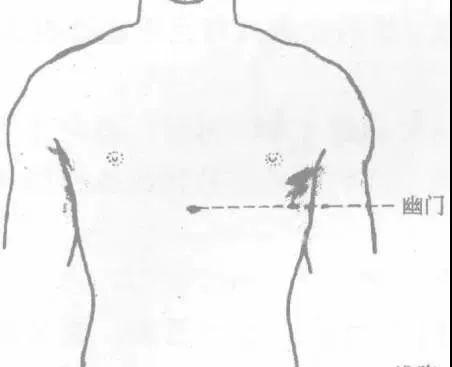 This hooking method can also be applied for gastric ptosis, inserting the needle at the right pylorus point, angling towards the left side of the stomach until it is level with the navel, then twisting the needle handle slightly while pulling up. Another person can hold the patient’s leg and push it upwards, synchronizing the action with the needle pulling. The patient’s leg should be flexed and extended three times, then allow the patient to hold the needle handle for 30 minutes before removing it. For uterine prolapse, insert the needle at Wei Bao (6 inches beside Guan Yuan), angling towards the reproductive organs, twisting and pulling the needle while flexing the leg upwards, with the needle handle operation being the same. The Wei Bao point can also treat kidney prolapse, referred to as the “three prolapse therapy.” The hooking needle method is named for the action of pulling the needle out, hence also called the “hooking needle therapy.” 15. Liver and Kidney Four Points Traditional Chinese medicine classifies hernias into seven types: cold hernia, disc hernia, cold hernia, symptom hernia, recurrent hernia, gas hernia, and pulse hernia. Generally, cold hernias can be reduced, or only the testicles may be swollen or drooping, making this method effective. If the hernia cannot be reduced, it is referred to as an incarcerated hernia in Western medicine. The liver and kidney four points are limited to cold and gas hernias. The liver and kidney meridians are closely related to the testicles. This method selects the liver meridian points Da Dun, Tai Chong, kidney meridian point Tai Xi, and spleen meridian point San Yin Jiao. Image of Tai Chong and Da Dun Points
This hooking method can also be applied for gastric ptosis, inserting the needle at the right pylorus point, angling towards the left side of the stomach until it is level with the navel, then twisting the needle handle slightly while pulling up. Another person can hold the patient’s leg and push it upwards, synchronizing the action with the needle pulling. The patient’s leg should be flexed and extended three times, then allow the patient to hold the needle handle for 30 minutes before removing it. For uterine prolapse, insert the needle at Wei Bao (6 inches beside Guan Yuan), angling towards the reproductive organs, twisting and pulling the needle while flexing the leg upwards, with the needle handle operation being the same. The Wei Bao point can also treat kidney prolapse, referred to as the “three prolapse therapy.” The hooking needle method is named for the action of pulling the needle out, hence also called the “hooking needle therapy.” 15. Liver and Kidney Four Points Traditional Chinese medicine classifies hernias into seven types: cold hernia, disc hernia, cold hernia, symptom hernia, recurrent hernia, gas hernia, and pulse hernia. Generally, cold hernias can be reduced, or only the testicles may be swollen or drooping, making this method effective. If the hernia cannot be reduced, it is referred to as an incarcerated hernia in Western medicine. The liver and kidney four points are limited to cold and gas hernias. The liver and kidney meridians are closely related to the testicles. This method selects the liver meridian points Da Dun, Tai Chong, kidney meridian point Tai Xi, and spleen meridian point San Yin Jiao. Image of Tai Chong and Da Dun Points Da Dun (Da Dun, Liver Meridian No. 1) is located at the junction of the first toe and the metatarsal bone (this point is also said to be 1 mm outside the corner of the toenail). When needling, pinch the toe and stretch it to needle at the joint. Tai Chong (Tai Chong, Liver Meridian No. 3) is located on the dorsum of the foot, in the depression before the junction of the first and second metatarsal bones, resembling the He Gu point, but the metatarsal bones should not be spread apart. Image of Tai Xi and San Yin Jiao Points
Da Dun (Da Dun, Liver Meridian No. 1) is located at the junction of the first toe and the metatarsal bone (this point is also said to be 1 mm outside the corner of the toenail). When needling, pinch the toe and stretch it to needle at the joint. Tai Chong (Tai Chong, Liver Meridian No. 3) is located on the dorsum of the foot, in the depression before the junction of the first and second metatarsal bones, resembling the He Gu point, but the metatarsal bones should not be spread apart. Image of Tai Xi and San Yin Jiao Points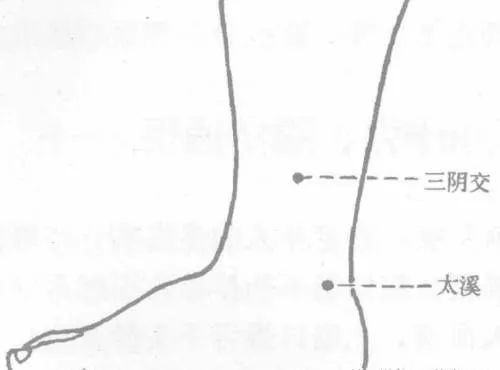 Tai Xi (Tai Xi, Kidney Meridian No. 3) is located in the depression between the high point of the inner ankle and the Achilles tendon. San Yin Jiao (San Yin Jiao, Spleen Meridian No. 6) is located 3 inches above the high point of the inner ankle, at the posterior edge of the tibia. 16. Abdominal Points for Constipation Constipation is a common condition, especially prevalent among the elderly. It is primarily caused by slow colonic peristalsis, leading to prolonged fecal retention in the colon, resulting in reabsorption of toxins into the bloodstream, causing dryness of the mouth and tongue, dizziness, and inability to pass stool. The pain is unbearable. Treatment involves inserting a subcutaneous needle at the left abdominal point, often resulting in immediate bowel movement. Abdominal Point (Fu Jie, Spleen Meridian No. 14) is located 1.3 inches directly below the navel, 4 inches to the left of the navel. The left abdominal point corresponds to the descending colon, and the continuous stimulation of the subcutaneous needle accelerates colonic peristalsis, facilitating natural bowel movements. Case Example: Liu XX, a 60-year-old housewife, suffered from chronic constipation, which had worsened recently, leading to dizziness, dry mouth, and poor appetite, with a constant urge to defecate but unable to do so. She had used laxatives without effect and had taken internal medications such as Ma Ren Zi, Zi Pi, and Tao Ren Cheng Qi without success. After a month of constipation and unbearable pain, she presented with a depressed expression. A subcutaneous needle was inserted at the left abdominal point, and the next morning she had a bowel movement, feeling as if her illness had vanished. She returned for a follow-up with a beaming smile and was given herbal medicine to regulate her spleen and stomach, leading to her recovery. 17. Multiple Needle Technique for Treating Ganglion Cysts Ganglion cysts often arise from strains or sprains and are common on the wrist and back of the hand, varying in size and often persisting for years or gradually increasing. Acupuncture treatment is relatively simple. Needling Technique: With the left hand, stabilize the cyst, using a 0.5-inch short needle, preferably 28-gauge, in the right hand, adjusting the number of needles based on the size of the cyst. Generally, needle one in the center of the cyst and one around it, and for larger cysts, additional horizontal needling along the base may be performed. If mucus is expelled, wipe it away with a dry cotton ball. Treatment is done every other day, and several sessions can lead to resolution. There are numerous cases, too many to enumerate. 18. Chronic Laryngitis Chronic laryngitis is painless but causes hoarseness and persists for a long time. Image of Lama Point
Tai Xi (Tai Xi, Kidney Meridian No. 3) is located in the depression between the high point of the inner ankle and the Achilles tendon. San Yin Jiao (San Yin Jiao, Spleen Meridian No. 6) is located 3 inches above the high point of the inner ankle, at the posterior edge of the tibia. 16. Abdominal Points for Constipation Constipation is a common condition, especially prevalent among the elderly. It is primarily caused by slow colonic peristalsis, leading to prolonged fecal retention in the colon, resulting in reabsorption of toxins into the bloodstream, causing dryness of the mouth and tongue, dizziness, and inability to pass stool. The pain is unbearable. Treatment involves inserting a subcutaneous needle at the left abdominal point, often resulting in immediate bowel movement. Abdominal Point (Fu Jie, Spleen Meridian No. 14) is located 1.3 inches directly below the navel, 4 inches to the left of the navel. The left abdominal point corresponds to the descending colon, and the continuous stimulation of the subcutaneous needle accelerates colonic peristalsis, facilitating natural bowel movements. Case Example: Liu XX, a 60-year-old housewife, suffered from chronic constipation, which had worsened recently, leading to dizziness, dry mouth, and poor appetite, with a constant urge to defecate but unable to do so. She had used laxatives without effect and had taken internal medications such as Ma Ren Zi, Zi Pi, and Tao Ren Cheng Qi without success. After a month of constipation and unbearable pain, she presented with a depressed expression. A subcutaneous needle was inserted at the left abdominal point, and the next morning she had a bowel movement, feeling as if her illness had vanished. She returned for a follow-up with a beaming smile and was given herbal medicine to regulate her spleen and stomach, leading to her recovery. 17. Multiple Needle Technique for Treating Ganglion Cysts Ganglion cysts often arise from strains or sprains and are common on the wrist and back of the hand, varying in size and often persisting for years or gradually increasing. Acupuncture treatment is relatively simple. Needling Technique: With the left hand, stabilize the cyst, using a 0.5-inch short needle, preferably 28-gauge, in the right hand, adjusting the number of needles based on the size of the cyst. Generally, needle one in the center of the cyst and one around it, and for larger cysts, additional horizontal needling along the base may be performed. If mucus is expelled, wipe it away with a dry cotton ball. Treatment is done every other day, and several sessions can lead to resolution. There are numerous cases, too many to enumerate. 18. Chronic Laryngitis Chronic laryngitis is painless but causes hoarseness and persists for a long time. Image of Lama Point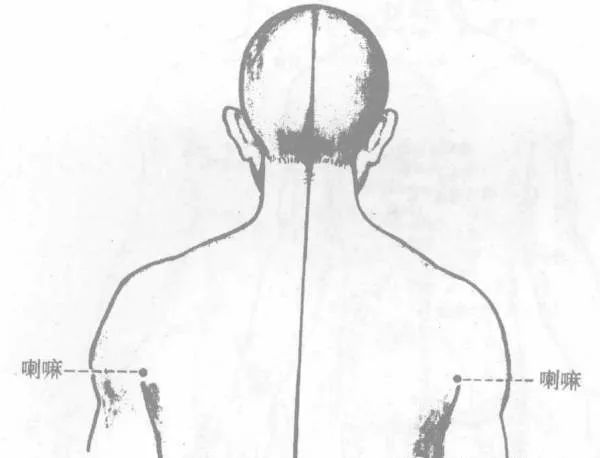 The point is called Lama, derived from Tibetan medicine, and is very effective. Location: At the head of the seam in the back of the armpit. Needling Technique: For the initial visit, use a fine needle to needle Shao Shang, and a three-edged needle to needle Jin Jin and Yu Ye to induce bleeding. On follow-up visits, needle the Lama point alone, at a depth of 1 to 1.5 inches, depending on the patient’s body type. Technique: Needle Shao Shang, Jin Jin, and Yu Ye to induce bleeding. For the Lama point, slowly rotate the needle, using even techniques to advance and retreat three times for five minutes. Afterward, needle the Lama point alone, every other day. Leave the needle in for 20 minutes, then perform the previous techniques. This rotation should be slow, avoiding pain for the patient, and the third technique should be performed after a 10-minute interval. When the needle is effective, the sensation travels down to the fingers, and upon rotation, it ascends to the throat, providing relief, and then leave for another 10 minutes before removing the needle. Initially, treat every other day, then twice a week, and eventually once a week until recovery.
The point is called Lama, derived from Tibetan medicine, and is very effective. Location: At the head of the seam in the back of the armpit. Needling Technique: For the initial visit, use a fine needle to needle Shao Shang, and a three-edged needle to needle Jin Jin and Yu Ye to induce bleeding. On follow-up visits, needle the Lama point alone, at a depth of 1 to 1.5 inches, depending on the patient’s body type. Technique: Needle Shao Shang, Jin Jin, and Yu Ye to induce bleeding. For the Lama point, slowly rotate the needle, using even techniques to advance and retreat three times for five minutes. Afterward, needle the Lama point alone, every other day. Leave the needle in for 20 minutes, then perform the previous techniques. This rotation should be slow, avoiding pain for the patient, and the third technique should be performed after a 10-minute interval. When the needle is effective, the sensation travels down to the fingers, and upon rotation, it ascends to the throat, providing relief, and then leave for another 10 minutes before removing the needle. Initially, treat every other day, then twice a week, and eventually once a week until recovery.
I Disclaimer:
This article is selected from:the internet. The articles shared by this public account are for reference and learning purposes only. If there are any inappropriate uses of the published content, please feel free to contact us. Please retain copyright information when reprinting. All formulas and treatments mentioned in the text are for learning reference only; non-professionals should not attempt to use them!

